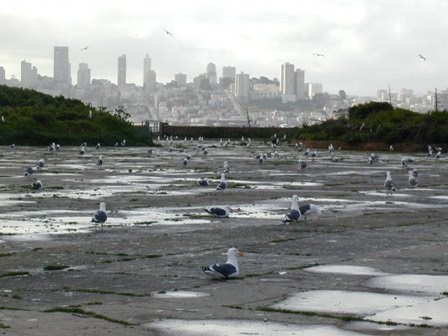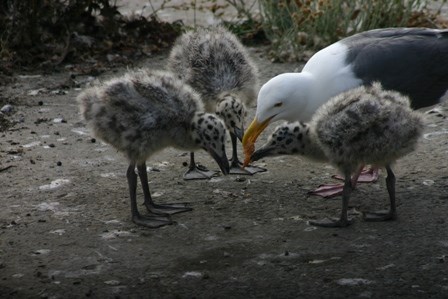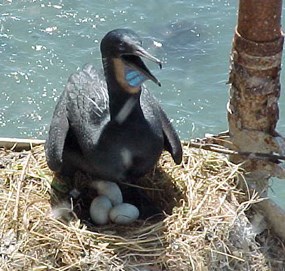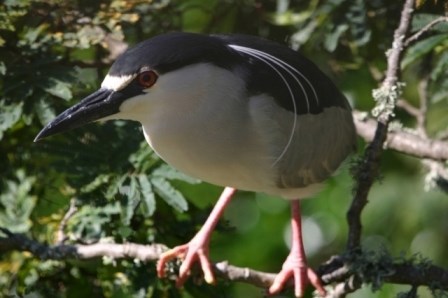
A visit to the island is full of a surprising wealth and variety of bird life. Even before arriving on Alcatraz, a visitor will notice the large numbers of gulls and cormorants active in the waters surrounding the island. The familiar call of the dominant Western Gull will be heard from birds swooping into the Bay waters foraging for fish. Disembarking from the ferry, and glancing up onto the heavily overgrown wall above the amphitheater, you may spot a Black-crowned Night-Heron sitting quietly and saving its energy for its evening forays. Walking up the road towards the cell house, you may spot some landbirds such as White-crowned Sparrow, Anna’s Hummingbird, Song Sparrow, and Black Phoebe. In the tall cypress trees, Common Ravens are gripping branches, surveying the situation and perhaps waiting for careless gull parents to be distracted long enough that they can successfully kidnap a young chick or steal an egg. As you reach the western side of the island, you may spy Snowy Egrets, Night-Herons, Black Oystercatchers, and others hunting for shellfish in the tidepools or rocky cliffs. Cormorants of several species can be seen preening and sometimes drying their wings on the rocky cliffs. If you peer over the railing (not too far!) above Barker Beach and look carefully at rock crevices in the cliff below, you may see a Pigeon Guillemot calling from its nest burrow.
![SNEG- GHintrees[web]](/alca/learn/photosmultimedia/images/SNEG-GHintrees-web.jpg?maxwidth=650&autorotate=false)
Most of the birds nest on the steep cliffs, but others nest in ornamental shrubs. In the late 1800s, the military reshaped Alcatraz to make a fortress. Rock rubble was pushed outward into the bay around Alcatraz's perimeter creating tide pools. Soil brought onto the island to deaden the force of potential incoming enemy shells was also used to plant flowering shrubs that have become excellent nesting habitat for these birds. To help preserve Alcatraz's wildlife during the breeding season, from February to September parts of the island are closed to the public, allowing breeding birds to nest. Common Nesting Birds
Western Gull (Larus occidentalis) The most common bird on Alcatraz is the Western Gull. An opportunistic bird, the Gull eats a variety of food, but is healthiest with its natural food, fish and invertebrates from the bay. When it comes to finding a mate, the female approaches the male in a bowed posture, so the male doesn't think she's going to compete for his territory. If he is interested in her, he regurgitates a meal for them to eat, and with luck, they stay mated for life (average life span being 15-18 years). 
Cormorants (Phalacrocorax sp.) Three species of cormorants utilize Alcatraz: the Double-crested Cormorant, the Brandt's Cormorant, and the Pelagic Cormorant. The Double-crested Cormorant is about the same size as the Brandt's Cormorant, but it has an orange-colored throat pouch compared to the Brandt's blue one. The Pelagic Cormorant is the smallest of the three. The Brandt's and the Pelagic Cormorants are more common and breed on Alcatraz. In fact, Alcatraz is the only breeding colony site for these two species in the San Francisco Bay. Any boat traffic within 100 yards of the west, north, or south sides of the island can disturb the cormorants and impair their nesting success. 
Black-crowned Night-Heron (Nycticorax nycticorax) and Snowy Egret (Egretta thula) The Black-crowned Night-Heron and Snowy Egret were almost hunted to extinction in the early 1900s. Their head plumes were a popular decoration for ladies' hats and shoes. The two species are closely related, “cousins” persay, and both nest in the ornamental shrubs on the island. When disturbed, they flush off their nests, allowing gulls and ravens to eat their eggs and young. Both birds feast on plentiful prey dwelling in the tide pools below. ![pigu tara[web]](/alca/learn/photosmultimedia/images/pigu-tara-web.jpg?maxwidth=650&autorotate=false)
Pigeon Guillemot (Cepphus columba) A visitor may first detect the presence of this foot-long bird by its startling high-pitched call. Your eyes may be drawn to the bird also by its brightly-colored red-orange feet and red-colored mouth lining. On the waters offshore near Barker Beach or the Officer’s Club where it is often seen, the white patches on the upper wings set off the otherwise black feathers. These birds are classified as alcids, the northern hemisphere equivalent of penguins. Alcatraz Waterbird Research |
Last updated: December 17, 2020
